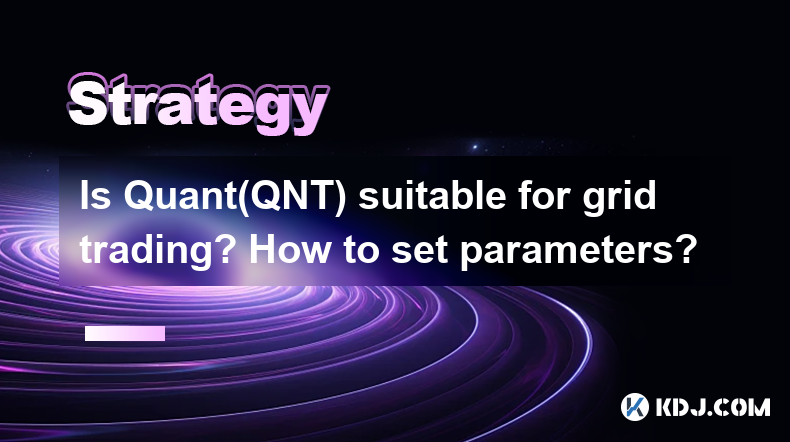-
 bitcoin
bitcoin $124586.364639 USD
0.62% -
 ethereum
ethereum $4670.671710 USD
3.33% -
 xrp
xrp $2.983701 USD
0.18% -
 tether
tether $1.000175 USD
-0.03% -
 bnb
bnb $1209.430642 USD
2.76% -
 solana
solana $231.365861 USD
0.51% -
 usd-coin
usd-coin $0.999665 USD
-0.02% -
 dogecoin
dogecoin $0.264657 USD
4.46% -
 tron
tron $0.346415 USD
1.60% -
 cardano
cardano $0.871586 USD
3.70% -
 chainlink
chainlink $23.451270 USD
7.56% -
 hyperliquid
hyperliquid $46.860071 USD
-2.96% -
 ethena-usde
ethena-usde $1.000120 USD
0.04% -
 sui
sui $3.611279 USD
1.08% -
 stellar
stellar $0.407149 USD
0.96%
Is Quant(QNT) suitable for grid trading? How to set parameters?
QNT's volatility and liquidity make it suitable for grid trading; set parameters carefully on platforms like Binance to optimize profits and manage risks effectively.
May 03, 2025 at 06:42 pm

Grid trading is a popular strategy among cryptocurrency traders, which involves setting buy and sell orders at regular intervals within a specified price range. This strategy can be particularly effective for assets that exhibit a degree of volatility but also maintain a certain level of stability. In this article, we will explore whether Quant (QNT) is suitable for grid trading and provide a detailed guide on how to set the parameters for this strategy.
Understanding Quant (QNT)
Quant (QNT) is the native token of the Quant Network, a blockchain operating system that connects various blockchains and networks. QNT is used to access the Overledger platform, which facilitates interoperability between different blockchain ecosystems. The token's primary use is for licensing fees and network services, which can contribute to its price stability and potential for growth.
QNT has shown a history of volatility, which is common among cryptocurrencies. However, it also has periods of relative stability, making it a potential candidate for grid trading. The key to determining its suitability lies in analyzing its price movements and volatility patterns.
Suitability of QNT for Grid Trading
To determine if QNT is suitable for grid trading, we need to consider several factors:
- Volatility: QNT's price can experience significant fluctuations, which is a critical factor for grid trading. High volatility can lead to more frequent trades and potentially higher profits, but it also increases the risk.
- Liquidity: QNT has sufficient liquidity on major exchanges, which is essential for executing grid trading strategies effectively. High liquidity ensures that orders can be filled quickly and at the desired price levels.
- Market Trends: Analyzing QNT's historical price data can help identify trends and patterns that are conducive to grid trading. For instance, if QNT tends to move within a specific range over a period, it may be more suitable for grid trading.
Based on these factors, QNT can be considered suitable for grid trading, especially during periods of moderate volatility and when the market is trending within a predictable range.
Setting Up Grid Trading for QNT
To set up grid trading for QNT, you will need to use a trading platform that supports this strategy. Many exchanges and trading bots offer grid trading features. Here is a step-by-step guide on how to set up grid trading for QNT:
- Choose a Trading Platform: Select a platform that supports grid trading for QNT. Examples include Binance, KuCoin, and various trading bots like 3Commas or Cryptohopper.
- Determine the Price Range: Analyze QNT's recent price movements to set an appropriate price range for your grid. For example, if QNT has been trading between $100 and $150 over the past month, you might set your grid within this range.
- Set the Grid Interval: Decide on the interval between each buy and sell order. A smaller interval can lead to more frequent trades but may also increase transaction costs. For instance, if your range is $100 to $150, you might set intervals of $5.
- Define the Number of Grids: Calculate the number of grids based on your price range and interval. In the above example, you would have 10 grids (from $100 to $150 with $5 intervals).
- Set the Investment Amount: Determine how much QNT you want to invest in the grid. This amount will be distributed across the buy orders within your grid.
- Configure the Grid: Enter the parameters into your trading platform. This typically involves setting the upper and lower price limits, the grid interval, and the investment amount.
- Monitor and Adjust: Once your grid is set up, monitor its performance and be prepared to adjust the parameters if market conditions change.
Example of Setting Up a Grid for QNT
Let's walk through an example of setting up a grid for QNT on the Binance platform:
- Log into Binance: Access your Binance account and navigate to the grid trading section.
- Select QNT/USDT Pair: Choose the QNT/USDT trading pair for your grid.
- Set the Price Range: Based on recent data, set the upper limit at $150 and the lower limit at $100.
- Choose the Grid Interval: Set the interval to $5, resulting in 10 grids.
- Enter the Investment Amount: Decide to invest $1,000 in QNT. This amount will be distributed across the buy orders.
- Configure the Grid: Enter the parameters into the grid trading tool on Binance. The tool will automatically calculate the number of grids and the amount of QNT to buy at each level.
- Review and Confirm: Review your settings and confirm the grid setup. The platform will then place the buy and sell orders according to your grid.
Managing Risks in Grid Trading QNT
While grid trading can be profitable, it also comes with risks. Here are some strategies to manage these risks when trading QNT:
- Stop-Loss Orders: Consider setting stop-loss orders to limit potential losses if the market moves against your grid.
- Regular Monitoring: Keep an eye on your grid's performance and be ready to adjust the parameters if necessary. Market conditions can change rapidly, and timely adjustments can help mitigate losses.
- Diversification: Do not put all your funds into a single grid. Diversify your investments across different assets and strategies to spread the risk.
- Understanding Market Conditions: Stay informed about the broader market trends and news that could impact QNT's price. This knowledge can help you make more informed decisions about your grid trading strategy.
Optimizing Grid Trading Parameters for QNT
To optimize your grid trading strategy for QNT, consider the following tips:
- Backtesting: Use historical data to backtest your grid trading strategy. This can help you identify the most effective parameters for QNT.
- Adjusting the Grid Interval: Experiment with different grid intervals to find the optimal balance between trade frequency and transaction costs.
- Scaling the Grid: Consider scaling your grid based on market volatility. During periods of high volatility, you might want to widen your grid to capture larger price movements.
- Leveraging Market Analysis: Use technical analysis tools to identify key support and resistance levels for QNT. These levels can help you set more effective price ranges for your grid.
Frequently Asked Questions
Q: Can I use grid trading for QNT on any exchange?A: Not all exchanges support grid trading for QNT. You should check if your preferred exchange offers this feature for the QNT/USDT pair. Popular exchanges like Binance and KuCoin do support grid trading for QNT.
Q: How often should I adjust my grid trading parameters for QNT?A: The frequency of adjustments depends on market conditions. It's advisable to review your grid at least weekly and make adjustments if there are significant changes in QNT's price volatility or market trends.
Q: Is grid trading suitable for beginners trading QNT?A: Grid trading can be complex and requires a good understanding of market dynamics. While it can be used by beginners, it's recommended to start with a small investment and gain experience before scaling up.
Q: Can I automate grid trading for QNT?A: Yes, many trading platforms and bots offer automated grid trading features. You can set up your grid and let the platform execute the trades automatically based on your parameters.
Disclaimer:info@kdj.com
The information provided is not trading advice. kdj.com does not assume any responsibility for any investments made based on the information provided in this article. Cryptocurrencies are highly volatile and it is highly recommended that you invest with caution after thorough research!
If you believe that the content used on this website infringes your copyright, please contact us immediately (info@kdj.com) and we will delete it promptly.
- BlockDAG, DOGE, HYPE Sponsorship: Crypto Trends Shaping 2025
- 2025-10-01 00:25:13
- Deutsche Börse and Circle: A StableCoin Adoption Powerhouse in Europe
- 2025-10-01 00:25:13
- BlockDAG's Presale Buzz: Is It the Crypto to Watch in October 2025?
- 2025-10-01 00:30:13
- Bitcoin, Crypto, and IQ: When Genius Meets Digital Gold?
- 2025-10-01 00:30:13
- Stablecoins, American Innovation, and Wallet Tokens: The Next Frontier
- 2025-10-01 00:35:12
- NBU, Coins, and Crypto in Ukraine: A New Yorker's Take
- 2025-10-01 00:45:14
Related knowledge

Practical parameter settings for a Bitcoin multi-timeframe moving average system
Sep 18,2025 at 10:54pm
Optimizing Timeframe Combinations for Bitcoin Trading1. Selecting appropriate timeframes is crucial when building a multi-timeframe moving average sys...

How can I filter out false breakouts in Dogecoin high-frequency trading?
Sep 22,2025 at 01:00am
Understanding False Breakouts in Dogecoin Trading1. A false breakout occurs when Dogecoin's price appears to move beyond a defined support or resistan...

Techniques for identifying tops and bottoms in the Bitcoin on-chain NVT model
Sep 20,2025 at 07:54pm
Understanding the NVT Model in Bitcoin Analysis1. The Network Value to Transactions (NVT) ratio is often described as the 'P/E ratio' of the cryptocur...

What does the surge in open interest in Bitcoincoin futures mean?
Sep 20,2025 at 11:18pm
Understanding the Surge in Dogecoin Futures Open Interest1. A surge in open interest within Dogecoin futures indicates a growing number of active cont...

How can I use the Ethereum USDT premium to gauge market sentiment?
Sep 18,2025 at 11:55pm
Understanding the Ethereum USDT Premium1. The Ethereum USDT premium refers to the price difference between USDT (Tether) traded on Ethereum-based plat...

What should I do if Ethereum staking yields decline?
Sep 20,2025 at 06:18am
Understanding the Causes Behind Declining Ethereum Staking Yields1. The Ethereum network transitioned to a proof-of-stake consensus mechanism with the...

Practical parameter settings for a Bitcoin multi-timeframe moving average system
Sep 18,2025 at 10:54pm
Optimizing Timeframe Combinations for Bitcoin Trading1. Selecting appropriate timeframes is crucial when building a multi-timeframe moving average sys...

How can I filter out false breakouts in Dogecoin high-frequency trading?
Sep 22,2025 at 01:00am
Understanding False Breakouts in Dogecoin Trading1. A false breakout occurs when Dogecoin's price appears to move beyond a defined support or resistan...

Techniques for identifying tops and bottoms in the Bitcoin on-chain NVT model
Sep 20,2025 at 07:54pm
Understanding the NVT Model in Bitcoin Analysis1. The Network Value to Transactions (NVT) ratio is often described as the 'P/E ratio' of the cryptocur...

What does the surge in open interest in Bitcoincoin futures mean?
Sep 20,2025 at 11:18pm
Understanding the Surge in Dogecoin Futures Open Interest1. A surge in open interest within Dogecoin futures indicates a growing number of active cont...

How can I use the Ethereum USDT premium to gauge market sentiment?
Sep 18,2025 at 11:55pm
Understanding the Ethereum USDT Premium1. The Ethereum USDT premium refers to the price difference between USDT (Tether) traded on Ethereum-based plat...

What should I do if Ethereum staking yields decline?
Sep 20,2025 at 06:18am
Understanding the Causes Behind Declining Ethereum Staking Yields1. The Ethereum network transitioned to a proof-of-stake consensus mechanism with the...
See all articles










































































